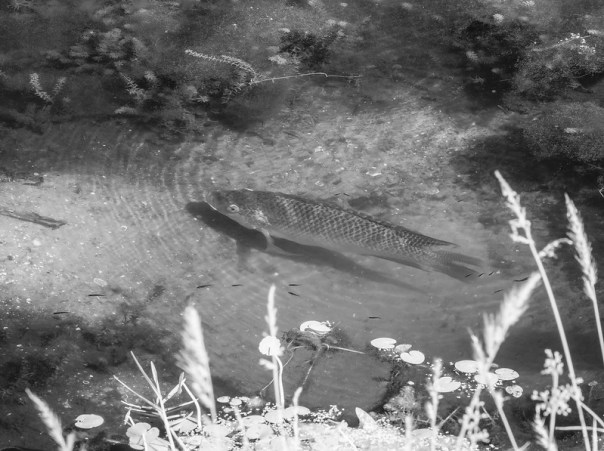Our weather here in Central Florida is finally starting to cool off a bit. I could definitely feel a difference when I set out for Merritt Island National Wildlife Refuge early last Monday. And the high temperature reached just 81ºF later that day. Our forecast for next weekend predicts highs in the mid 70s – the beginning of a very nice time of year!
Anyway, I came home with a number of photos I really like. This week I’m going to go way over my usual photo quota and share many of them. First, a couple of landscapes
 Beneath the bridge at daybreak: This is along side the A. Max Brewer Causeway, looking east into the refuge, about a half hour before sunrise.
Beneath the bridge at daybreak: This is along side the A. Max Brewer Causeway, looking east into the refuge, about a half hour before sunrise. Around the shore: Pretty light and calm water along Gator Creek Road, about 15 minutes before sunrise
Around the shore: Pretty light and calm water along Gator Creek Road, about 15 minutes before sunriseNext, some visitors. As pleasant as the cooler temperatures are, they also mean it’s time to start looking for some of our winter bird friends and I spotted several on my trip.
 Palm Warbler. They can be a little jumpy and hard to photograph. But this one sat still for a moment on an interesting and close perch, in nice light, with a good background. Doesn’t happen very often for me – I’m glad it was briefly cooperative.
Palm Warbler. They can be a little jumpy and hard to photograph. But this one sat still for a moment on an interesting and close perch, in nice light, with a good background. Doesn’t happen very often for me – I’m glad it was briefly cooperative. Adopt an Area: This Eastern Phoebe has adopted the refuge for a while.
Adopt an Area: This Eastern Phoebe has adopted the refuge for a while. Blue Wing Teal: A few ducks have started to show up too.
Blue Wing Teal: A few ducks have started to show up too.Of course we also have many of our normal residents around.
 Bottlenose Dolphin: The Dolphins and the Brown Pelicans were chasing plentiful fish in Haulover Canal
Bottlenose Dolphin: The Dolphins and the Brown Pelicans were chasing plentiful fish in Haulover CanalThe header image is a of a Brown Pelican that just caught a fish in the canal. It’s not that good of a photo, but I kept it because it shows an interesting moment in nature’s circle of life.
 Posing Anhiga: Anhigas are very common here but still well worth photographing when they pose against such a nice background in morning light.
Posing Anhiga: Anhigas are very common here but still well worth photographing when they pose against such a nice background in morning light. Dragonfly: These can be skittish too, but if you see one in pretty light, be patient and still. Often they’ll return to the same perch and you can squeeze your shutter button.
Dragonfly: These can be skittish too, but if you see one in pretty light, be patient and still. Often they’ll return to the same perch and you can squeeze your shutter button.I saw other birds on this trip, including Great Blue and Tri-colored Herons, Great and Snowy Egrets, White and Glossy Ibis, Ospreys, Belted Kingfishers (sorry couldn’t get a photo), Pied-billed Grebes, Mourning and Common Ground Doves, and others I’m forgetting. I also used the Merlin bird app a couple of times to listen to bird calls. It ID’d a Black Scoter. Those have been spotted before at MINWR, but I wasn’t able to find it to confirm.
I haven’t mentioned this in a while, so I’ll bring it up again: You can find out what birds are in an area on the ebird website: https://ebird.org. Their page for MINWR is here: https://ebird.org/barchart?byr=1900&eyr=2021&bmo=1&emo=12&r=L123565 and it shows what species are seen there during each month of the year – a fabulous resource!
You can click on each of these photos to see larger versions on Flickr. And I have a huge collection of MINWR images in this album: https://www.flickr.com/photos/edrosack/albums/72157627776386723
Changing the subject #1 : This week, Go take a look at Diane’s Swamp Sunflower post: https://lavenderdreamstoo.blogspot.com/2021/10/in-search-of-swamp-sunflower.html. She spotted them near the Pruitt Trailhead at Halpata Tastanaki Preserve and along the Marjorie Harris Carr Cross Florida Greenway trail. Wonderful photos Diane!
Changing the subject #2 : Halloween is next weekend so here’s one more photo from last Monday that fits with the holiday:
 Web and Mangrove
Web and MangroveOkay – I think that’s a long enough post for today! Thanks for stopping by and reading my blog. Please take care of yourselves and each other. And if you can, get out and see some nature. And make some photos!
©2021, Ed Rosack. All rights reserved
















































